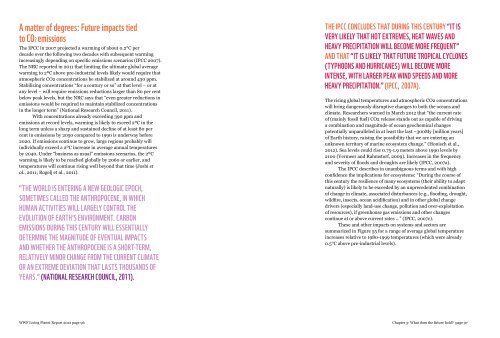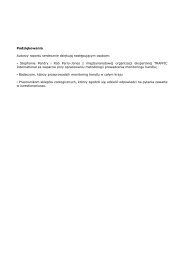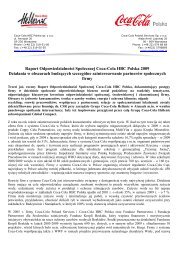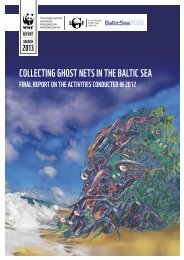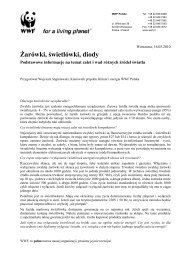Biodiversity, biocapacity and better choices
Biodiversity, biocapacity and better choices
Biodiversity, biocapacity and better choices
Create successful ePaper yourself
Turn your PDF publications into a flip-book with our unique Google optimized e-Paper software.
A matter of degrees: Future impacts tiedto CO2 emissionsThe IPCC in 2007 projected a warming of about 0.2°C perdecade over the following two decades with subsequent warmingincreasingly depending on specific emissions scenarios (IPCC 2007).The NRC reported in 2011 that limiting the ultimate global averagewarming to 2ºC above pre-industrial levels likely would require thatatmospheric CO2 concentrations be stabilized at around 430 ppm.Stabilizing concentrations “for a century or so” at that level – or atany level – will require emissions reductions larger than 80 per centbelow peak levels, but the NRC says that “even greater reductions inemissions would be required to maintain stabilized concentrationsin the longer term” (National Research Council, 2011).With concentrations already exceeding 390 ppm <strong>and</strong>emissions at record levels, warming is likely to exceed 2ºC in thelong term unless a sharp <strong>and</strong> sustained decline of at least 80 percent in emissions by 2050 compared to 1990 is underway before2020. If emissions continue to grow, large regions probably willindividually exceed a 2ºC increase in average annual temperaturesby 2040. Under “business as usual” emissions scenarios, the 2ºCwarming is likely to be reached globally by 2060 or earlier, <strong>and</strong>temperatures will continue rising well beyond that time (Joshi etal., 2011; Rogelj et al., 2011).“The world is entering a new geologic epoch,sometimes called the Anthropocene, in whichhuman activities will largely control theevolution of Earth’s environment. Carbonemissions during this century will essentiallydetermine the magnitude of eventual impacts<strong>and</strong> whether the Anthropocene is a short-term,relatively minor change from the current climateor an extreme deviation that lasts thous<strong>and</strong>s ofyears.” (National Research Council, 2011).The IPCC concludes that during this century “it isvery likely that hot extremes, heat waves <strong>and</strong>heavy precipitation will become more frequent”<strong>and</strong> that “it is likely that future tropical cyclones(typhoons <strong>and</strong> hurricanes) will become moreintense, with larger peak wind speeds <strong>and</strong> moreheavy precipitation.” (IPCC, 2007a).The rising global temperatures <strong>and</strong> atmospheric CO2 concentrationswill bring dangerously disruptive changes to both the oceans <strong>and</strong>climate. Researchers warned in March 2012 that “the current rateof (mainly fossil fuel) CO2 release st<strong>and</strong>s out as capable of drivinga combination <strong>and</strong> magnitude of ocean geochemical changespotentially unparalleled in at least the last ~300My [million years]of Earth history, raising the possibility that we are entering anunknown territory of marine ecosystem change.” (Honisch et al.,2012). Sea levels could rise 0.75-1.9 meters above 1990 levels by2100 (Vermeer <strong>and</strong> Rahmstorf, 2009). Increases in the frequency<strong>and</strong> severity of floods <strong>and</strong> droughts are likely (IPCC, 2007a).The IPCC describes in unambiguous terms <strong>and</strong> with highconfidence the implications for ecosystems: “During the course ofthis century the resilience of many ecosystems (their ability to adaptnaturally) is likely to be exceeded by an unprecedented combinationof change in climate, associated disturbances (e.g., flooding, drought,wildfire, insects, ocean acidification) <strong>and</strong> in other global changedrivers (especially l<strong>and</strong>-use change, pollution <strong>and</strong> over-exploitationof resources), if greenhouse gas emissions <strong>and</strong> other changescontinue at or above current rates …” (IPCC, 2007c).These <strong>and</strong> other impacts on systems <strong>and</strong> sectors aresummarized in Figure 55 for a range of average global temperatureincreases relative to 1980-1999 temperatures (which were already0.5°C above pre-industrial levels).WWF Living Planet Report 2012 page 96 Chapter 3: What does the future hold? page 97


